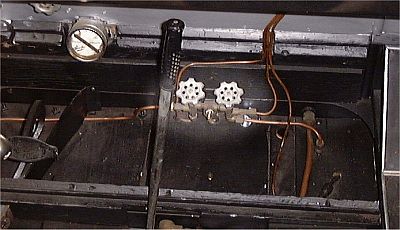|
Both fuel systems on a Stanley Steamer
are pressurized. The pilot fuel system is the simplest of the two.
A tank located under the front seat holds the pilot fuel (originally white
gasoline or camp stove fuel; today we use hexane because it burns very
cleanly and doesn't tend to foul the pilot vaporizer with carbon). In
order to get fuel from the pilot fuel tank to the pilot burner under the
boiler, the pilot tank is pressurized with air to 25 to 30 PSIG. When
the pilot fuel valve is opened (located near the pilot burner under the boiler at
the left side of the car) fuel is pressure fed to the pilot burner from the
pilot tank.
Filling the pilot tank requires that the cap for the pilot tank be loosened
until the pressure in the tank is relieved. The pressure of the pilot
tank is displayed on a gauge located on the dashboard. Once the pilot
tank has been filled two-thirds full of pilot fuel (the tank can't be filled
full as an air space is needed for pressurization) the pilot tank air valve
(left valve in the photo above; yellow valve in the piping diagram) is used
to repressurize the pilot tank to its proper pressure for operation.
The burner fuel system is more complex than the pilot fuel system.
During the operation of the car, over time, some of the air contained in the
service tanks will diffuse into the kerosene much the same way carbon
dioxide is diffused into carbonated sodas (it is the releasing of the carbon
dioxide from the soda when it is poured in a glass that causes the bubbling
action). The air diffusing into the kerosene results in a decrease in
the volume of air contained in the service tanks. It is the air that
provides the elastic properly within system and allows the pumps to actually
build and maintain fuel pressure. Reducing the volume of air in the
tanks increases the tank volume available for the pumps to store fuel in.
Unfortunately the reduction in air space also diminishes the elasticity of
the system such that each stroke of the fuel pump now has less air to push
against resulting in the tank pressure building faster.
As the volume of air in the tank
decreases it results in each stroke of the fuel pump building fuel pressure
faster. Thus the fuel gauge needle "bounces" such that each pump cycle increases the
pressure while the burner operation is working to drop the system pressure.
When the bouncing motion of the fuel pressure gauge needle is observed it is
an indication that air must be applied to the service tanks. This is
best accomplished the next time the car is fired up.
To add air to the service tanks the burner fuel
pressure is allowed to drop to 60 to 80 PSIG during the firing up of the car and then air is admitted to the
service tanks until the pressure reaches 120 to 130 PSIG (assuming the air
source is capable of supplying this pressure). Basically the system
pressure is being raised through the addition of air to the fuel pressure
tanks instead of liquid fuel being added with the hand fuel pump. The air source can then
be removed and the burner fuel pressure allowed to drop again. The
burner fuel system pressure is then pumped up using the hand fuel pump.
If each stroke of the hand fuel pump handle only moves the fuel pressure
needle the width of the needle or so then there is sufficient pressure in
the system. If the burner fuel pressure needle is moving a larger
increment then additional air should be added to the system a second time.
If the air supply is only in the 90 PSIG range then air will probably need
to be added several times before the system has the proper volume of air
contained in the service tanks. |
